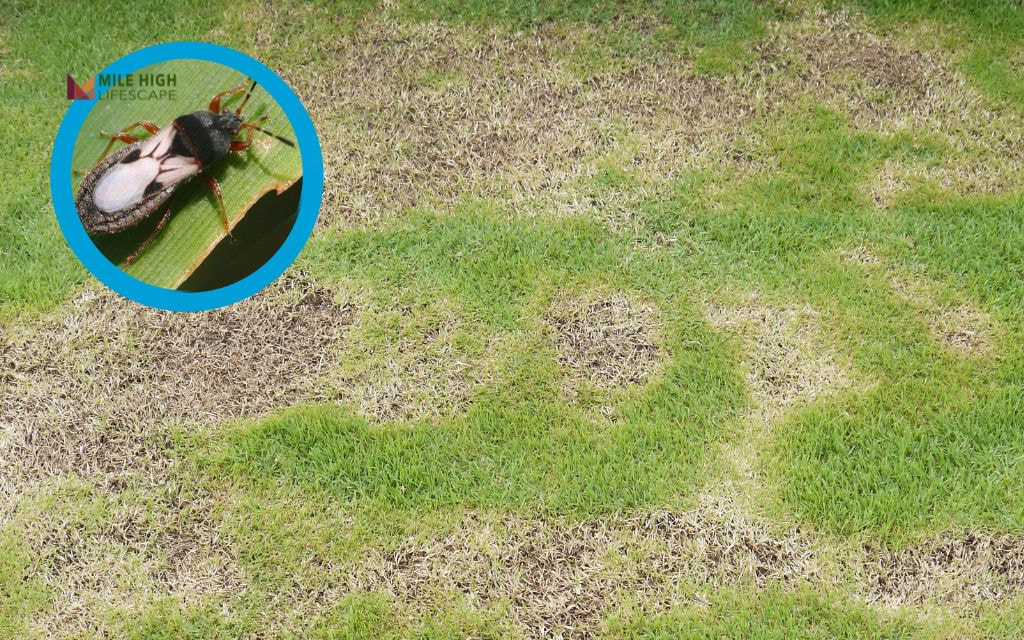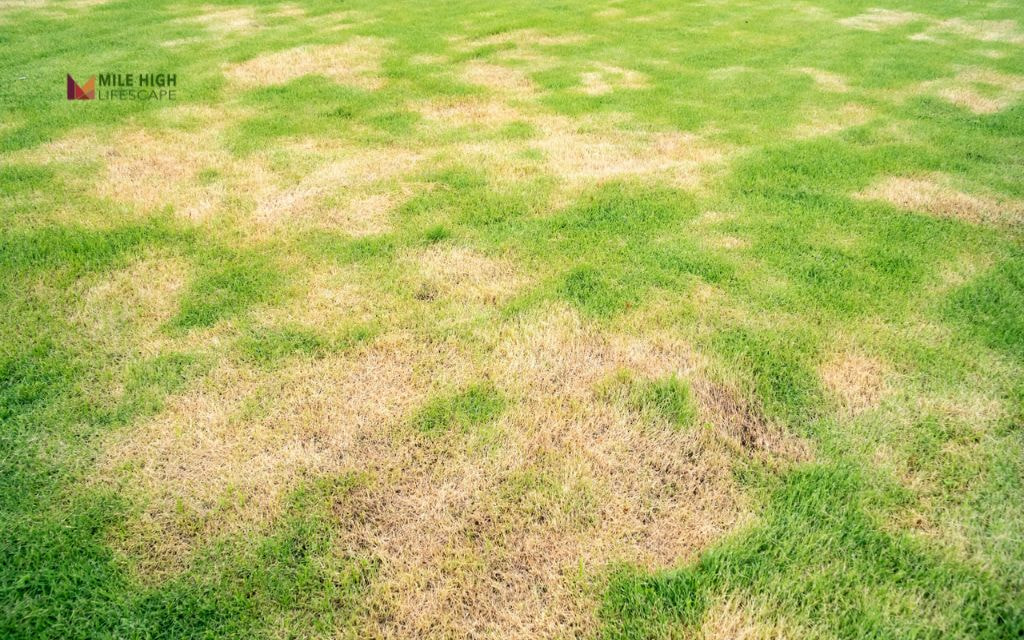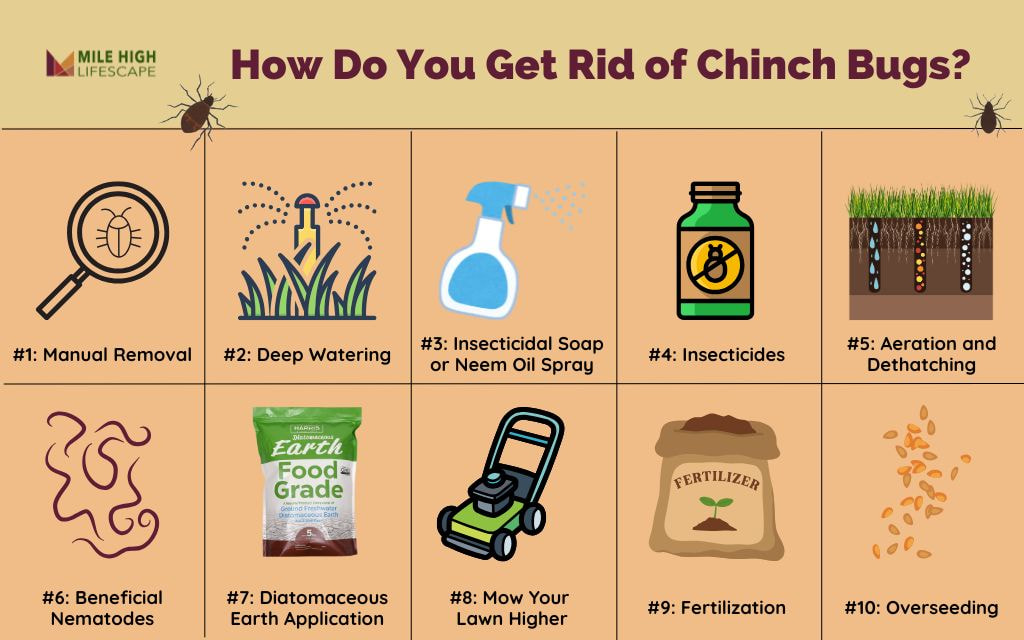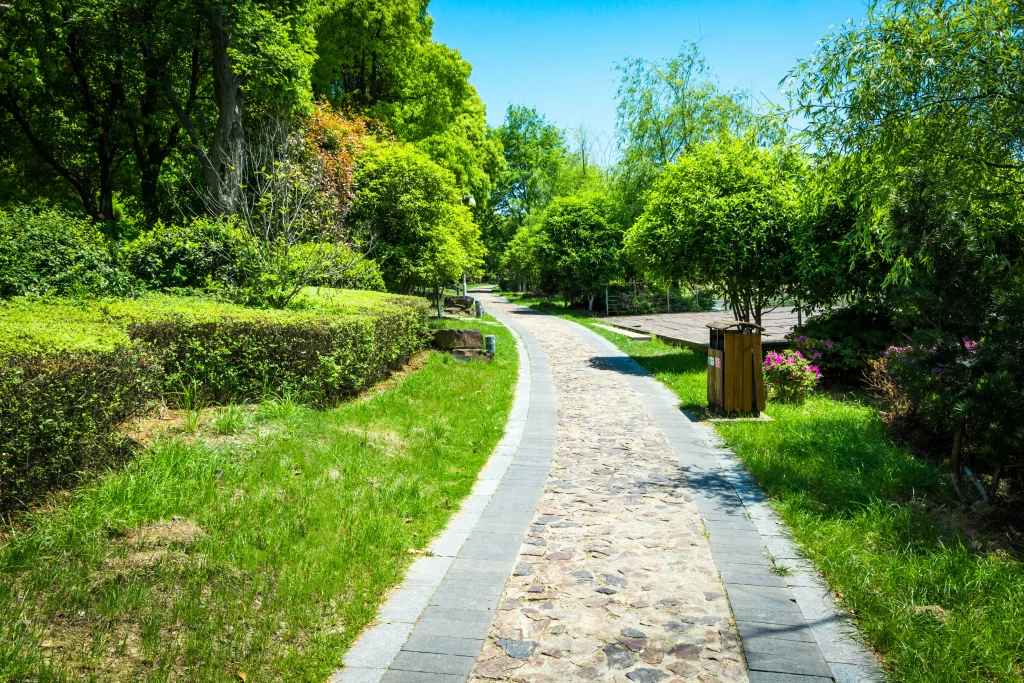Have you ever wondered “How do you get rid of chinch bugs in the lawn?”. If the answer is yes, you’re not alone. Chinch bugs rank among Denver’s most destructive lawn pests during summer months.
These tiny invaders thrive in our region’s hot, dry climate, making Kentucky bluegrass and fescue lawns particularly vulnerable to attack. The damage appears gradually – yellow patches turn brown, then die completely – often mimicking drought stress while watering provides no improvement.
In this article, you’ll discover exactly how to spot chinch bug infestations, 10 best ways to eliminate them, and how to protect your turf from future outbreaks. Let’s jump in!
What Are Chinch Bugs?
Chinch bugs are small insects (about 1/8 to 1/6 inch long) that feed by piercing grass blades and extracting plant fluids. This feeding injects toxins into the grass, causing it to wilt and die. The Hairy chinch bug (Blissus leucopterus hirtus) dominates in Colorado lawns.
Denver’s climate creates ideal conditions for chinch bug proliferation. These pests flourish during hot, dry periods when temperatures exceed 80°F – precisely our typical summer weather pattern.
They prefer full-sun areas and thrive in lawns with excessive thatch, where they hide, reproduce, and evade predators. A single female can produce up to 300 eggs, enabling populations to explode rapidly when conditions favor their development.

How to Tell If You Have Chinch Bugs in Your Lawn
Detecting chinch bugs early allows for more effective control. Look for these telltale signs:
Signs of Chinch Bug Damage:
- Grass transforms from yellow to brown, then dies in expanding patches
- Damage concentrates in sunny, drought-prone areas near concrete (sidewalks, driveways)
- Affected areas don’t green up despite extra irrigation – a clue it’s not just drought stress.
- Damage progresses outward from initial spots, creating a patchwork pattern
How to Check for Chinch Bugs:
- Perform the “can test”: Remove both ends of a coffee can, push it 2-3 inches into the soil in a transitional area (where yellow grass meets healthy grass), fill with water, and watch for small black insects floating to the surface within 5-10 minutes.
- Inspect the thatch layer: Part the grass at the edge of damaged areas and examine the soil surface with a magnifying glass. Look for small black insects with white wings folded across their backs – adults measure about 1/6 inch long.
- Check for nymphs: Young chinch bugs appear reddish with a white band across their backs. They move quickly when disturbed.

How Do You Get Rid of Chinch Bugs? (10 Solutions)
Combat chinch bugs using these proven methods, which we’ve refined through years of treating Denver lawns.
📢 Pro Tip for Best Results:
- Combine multiple approaches for complete control. For example, dethatch and aerate, then apply insecticidal soap, followed by overseeding with resistant grass varieties.
- Time treatments for early morning or evening when chinch bugs are active and temperatures are cooler for maximum impact.
#1: Manual Removal
Remove and bag thatch from affected areas to eliminate chinch bugs and their eggs. Use a dethatching rake or power dethatcher to pull up the layer of dead grass and organic matter where chinch bugs live.
Focus on the areas where damaged grass meets healthy grass – this transition zone contains active feeding populations. Bag the removed thatch immediately and dispose of it rather than composting to prevent reinfestation.
#2: Deep Watering
Water your lawn deeply (1-1.5 inches) once or twice weekly rather than light, frequent watering. Use a rain gauge or tuna can to measure water application.
This watering strategy promotes stronger root development that helps grass resist chinch bug damage. The key is penetration – water should soak 6-8 inches into the soil.
Water between 4-10 AM when evaporation rates are lowest and water pressure is typically better. Denver’s clay soils may require cycle-soak methods (water for 10-15 minutes, let absorb, then water again) to prevent runoff.
#3: Insecticidal Soap or Neem Oil Spray
Mix insecticidal soap according to package directions (typically 2-3 tablespoons per gallon of water) or neem oil (1-2 tablespoons per gallon).
Apply directly to affected areas using a pump sprayer, saturating the grass and thatch layer completely. Cover the damaged areas plus a 3-foot buffer zone around them.
These contact insecticides break down quickly, so apply when humidity is high and temperatures are below 85°F for maximum effectiveness. Most products require reapplication every 7-10 days for 2-3 treatments to control multiple life stages.
#4: Targeted Chemical Insecticides
For severe infestations, products containing bifenthrin, carbaryl, or cyfluthrin provide effective control. Apply using a hose-end sprayer or pump sprayer, focusing on the perimeter of damaged areas where insects actively feed.
Water lightly after application to move the product into the thatch layer where chinch bugs hide. These products typically remain effective for 30-60 days.
Always follow label rates – more isn’t better and may harm beneficial insects that help control chinch bugs naturally.
#5: Aeration and Dethatching
Rent a core aerator to remove small plugs of soil from your lawn, relieving compaction and creating channels for water and nutrients. Follow with dethatching to remove the organic debris layer where chinch bugs thrive.
The best timing for Denver lawns is September-October or April-May when grass recovers quickly.
For heavily thatched lawns (more than ½ inch), use a vertical mower or power rake set to appropriate depth. After these mechanical treatments, apply a thin layer of compost (¼ inch) to introduce beneficial microorganisms that help decompose remaining thatch.
#6: Apply Beneficial Nematodes
Purchase fresh beneficial nematodes (Steinernema carpocapsae) from a reputable garden center or online supplier. Apply them when soil temperatures reach 55-85°F for optimal activity.
Mix according to package directions and apply with a hose-end sprayer or watering can during evening hours.
Water the lawn before application, then again lightly afterward. Keep soil consistently moist (not saturated) for 7-14 days after application as nematodes need moisture to move through soil and locate prey.
One application can provide season-long protection if conditions remain favorable.
#7: Diatomaceous Earth Application
Spread food-grade diatomaceous earth (DE) at a rate of 2 pounds per 1,000 square feet using a fertilizer spreader or handheld shaker.
Apply when grass is dry for better adherence to insects.
Focus application on lawn edges, sunny areas, and transition zones between damaged and healthy grass. DE works physically rather than chemically, cutting the exoskeletons of insects that crawl through it and causing dehydration.
Reapply after heavy rain or irrigation. Wear a dust mask during application as the fine particles can irritate lungs if inhaled.
#8: Mow Your Lawn Higher
Adjust your mower height to cut grass at 3-3.5 inches during summer months. This height provides several benefits: deeper roots develop, soil stays cooler, moisture retention improves, and grass blades provide more photosynthetic surface to produce energy for recovery.
Never remove more than one-third of the grass blade in a single mowing.
Use a sharp blade to make clean cuts that heal quickly and reduce stress on the grass. Consider mulching clippings when possible to return nutrients to the soil without adding to thatch buildup.
#9: Fertilize Smartly
Apply a balanced fertilizer with an N-P-K ratio like 16-4-8 or similar, using no more than 3-4 pounds of nitrogen per 1,000 square feet annually, divided into 2-3 applications.
Time applications for early spring and fall in Denver, avoiding summer fertilization when chinch bugs are most active.
Controlled-release formulations prevent sudden growth flushes that attract pests. Consider adding iron supplements in summer instead of nitrogen to maintain green color without promoting excessive growth. A soil test from Colorado State University Extension can determine exactly what your lawn needs.
#10: Overseed Thin Lawn Areas
Select endophyte-enhanced perennial ryegrass or tall fescue varieties specifically bred to resist insect feeding. Prepare areas by mowing short (2 inches) and raking to expose soil.
Apply seed at recommended rates using a broadcast or drop spreader, then rake lightly to ensure good seed-to-soil contact. Cover with a thin layer of compost or topsoil (¼ inch) to retain moisture.
Water lightly 2-3 times daily for the first two weeks to keep the seedbed consistently moist. Reduce irrigation frequency but increase duration as seedlings establish. Most cool-season grasses germinate in 7-14 days and require 4-8 weeks to mature enough to withstand foot traffic.

How to Prevent Chinch Bugs from Coming Back
Implement these prevention strategies to maintain a chinch bug-free lawn in Denver’s challenging climate:
- Annual Core Aeration: Schedule core aeration each fall to reduce thatch accumulation and soil compaction. This improves water infiltration and root development while disrupting chinch bug habitat.
- Strategic Fertilization: Apply slow-release fertilizers according to soil test recommendations, avoiding excess nitrogen. Balance nutrient levels to promote steady, strong growth rather than rapid, succulent growth that attracts pests.
- Water Management: Practice deep, infrequent watering (1-1.5 inches weekly) during morning hours. This schedule promotes deep root development and reduces surface moisture that contributes to thatch buildup.
- Resistant Grass Selection: When establishing or renovating your lawn, choose endophyte-enhanced tall fescue or perennial ryegrass varieties with natural chinch bug resistance. These grasses contain natural compounds that deter feeding.
- Regular Overseeding: Maintain thick turf by overseeding thin areas each fall. Dense lawns naturally suppress pests and recover faster from damage. Use a mix of compatible grass varieties to enhance overall lawn resilience.
When to Call a Professional Lawn Care Company
While many chinch bug problems can be handled with DIY or organic methods, some situations in Denver require expert attention from Mile High Lifescape’s professional chinch bug control team.
Call in the pros if you notice:
- Rapidly spreading brown, dead patches in your lawn
- DIY chinch bug treatments not providing results
- Your lawn requires extensive overseeding, aeration, or pesticide application
How Mile High Lifescape Can Help:
- Accurate chinch bug diagnosis using up-to-date turf monitoring techniques
- Safe and effective insecticide applications, including Bifenthrin and modern options, tailored to Colorado regulations
- Comprehensive repair plans: core aeration, overseeding with endophyte-enhanced turfgrasses, and tailored fertilization
- Year-round lawn care plans for long-term prevention and healthy, vibrant grass
Don’t let chinch bugs take over: our experts can restore and protect your lawn with proven, professional methods.
Conclusion
Effective chinch bug management requires prompt detection, targeted treatment, and consistent prevention. By combining cultural practices like proper mowing and watering with strategic interventions, you can eliminate these destructive pests and prevent their return.
For severe infestations or complete lawn rehabilitation, Mile High Lifescape offers comprehensive solutions tailored to Denver’s unique growing conditions. Our lawn care specialists bring nearly two decades of local experience to every property we service.
Contact us today for a free lawn inspection and customized chinch bug control program.
Frequently Asked Questions (FAQs)
What is the best thing to kill chinch bugs?
The best thing to kill chinch bugs is a targeted lawn insecticide with bifenthrin as the active ingredient, or a professional-grade chinch bug treatment from a Denver lawn care specialist. For organic options, beneficial nematodes and insecticidal soaps provide effective control without synthetic chemicals.
Does Dawn dish soap kill chinch bugs?
Yes, a diluted mixture of Dawn dish soap sprayed onto your lawn can help suffocate chinch bugs on contact. However, for large infestations, professional chinch bug control or lawn insecticides may be needed for full eradication.
What causes chinch bug infestation?
Chinch bug infestation is mainly triggered by hot, dry weather and thick thatch layers in the lawn. Denver’s dry climate and over-fertilized, lush lawns provide the perfect conditions for chinch bugs to thrive.
Can grass recover from chinch bugs?
Yes, grass can often recover from chinch bug damage with prompt removal of infestations, core aeration, overseeding with resilient grasses, and smart lawn care practices. Severely damaged areas may need reseeding or sodding.
Will chinch bugs go away on their own?
No, chinch bugs will not go away on their own. Without removal or treatment, their populations tend to increase and spread – potentially destroying large sections of lawn throughout the Denver growing season.
